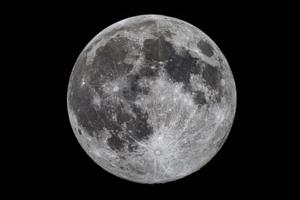Science
Major Asteroid Enters Orbit, Sparks Moon Debate Among Scientists

A significant asteroid has entered Earth’s orbit, prompting discussions among scientists about its implications for our understanding of the moon. Some experts are suggesting that this asteroid, which exhibits behavior similar to that of the moon, may be considered a second moon. This assertion, however, requires careful examination.
The asteroid, designated as 2023 FX18, began orbiting Earth in early March 2024. Its trajectory and rotation around the planet mimic the characteristics of the moon, leading to speculation about its classification. While it is rotating in a stable orbit, experts caution against labeling it as an equal to Earth’s natural satellite.
NASA’s planetary defense team has been closely monitoring this asteroid. According to Dr. Linda Morales, a leading astrophysicist at NASA, “This asteroid does demonstrate some moon-like qualities, but it is crucial to recognize the differences. Our moon is significantly larger and has a unique geological history that this asteroid does not possess.”
The size of 2023 FX18 is estimated to be approximately 200 meters in diameter, making it considerably smaller than the moon, which has a diameter of about 3,474 kilometers. This size difference is one of the key factors that distinguishes the two celestial bodies. While the asteroid’s orbit may resemble that of the moon, its classification as a second moon remains contentious among scientists.
Astronomy enthusiasts and the general public have responded with excitement to the news. Social media platforms are abuzz with discussions about the implications of a second moon. Many are sharing images of the asteroid captured by telescopes, showcasing its movement in the night sky.
Despite the enthusiasm, experts emphasize the importance of maintaining clarity in such discussions. Dr. Samuel Lee, an astrophysicist at the European Space Agency, states, “We must communicate accurately about these discoveries. While it is fascinating to observe asteroids entering our orbit, they do not change the fundamental characteristics of the moon we have known for centuries.”
The ongoing debate highlights the evolving nature of space exploration and our understanding of celestial bodies. As technology advances, more discoveries like 2023 FX18 are expected, offering new insights into our solar system.
In summary, while 2023 FX18 presents interesting characteristics that resemble those of the moon, it is essential to recognize the distinctions between it and Earth’s only natural satellite. The exploration of such bodies continues to enrich our knowledge of space and may lead to further discoveries in the future.
-

 Lifestyle5 months ago
Lifestyle5 months agoLibraries Challenge Rising E-Book Costs Amid Growing Demand
-

 Sports4 months ago
Sports4 months agoTyreek Hill Responds to Tua Tagovailoa’s Comments on Team Dynamics
-

 Sports4 months ago
Sports4 months agoLiverpool Secures Agreement to Sign Young Striker Will Wright
-

 Lifestyle4 months ago
Lifestyle4 months agoSave Your Split Tomatoes: Expert Tips for Gardeners
-

 Lifestyle4 months ago
Lifestyle4 months agoPrincess Beatrice’s Daughter Athena Joins Siblings at London Parade
-

 Science4 months ago
Science4 months agoSan Francisco Hosts Unique Contest to Identify “Performative Males”
-

 World4 months ago
World4 months agoWinter Storms Lash New South Wales with Snow, Flood Risks
-

 Science5 months ago
Science5 months agoTrump Administration Moves to Repeal Key Climate Regulation
-

 Business5 months ago
Business5 months agoSoFi Technologies Shares Slip 2% Following Insider Stock Sale
-

 Science5 months ago
Science5 months agoNew Tool Reveals Link Between Horse Coat Condition and Parasites
-

 Sports4 months ago
Sports4 months agoElon Musk Sculpture Travels From Utah to Yosemite National Park
-

 Science5 months ago
Science5 months agoNew Study Confirms Humans Transported Stonehenge Bluestones









